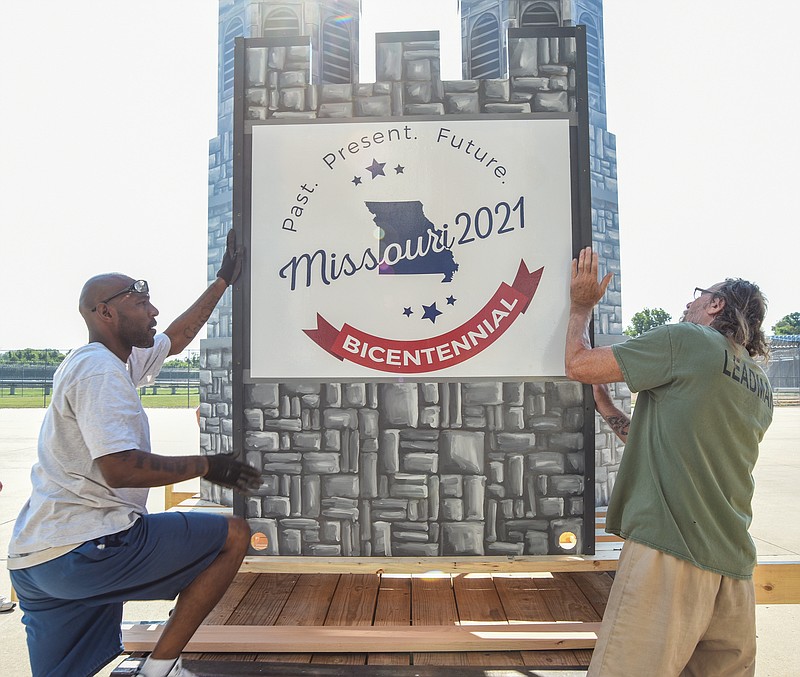Depicting the old Missouri State Penitentiary, the Missouri Department of Corrections' Bicentennial parade float is a testament to the department's history and rehabilitation-focused present.
Designed, constructed and hand-painted by offenders at Jefferson City Correctional Center, the DOC parade float has been in development for almost two months.
The float is a model version of MSP, a state-run prison that was shut down in 2004 and is now used for tours and educational purposes.
Roughly 15-20 offenders from JCCC's restorative justice program and the Missouri Vocational Enterprise furniture factory worked on the float in one way or another.
"It's a labor of love for these guys," JCCC Deputy Warden Myles Strid said. "These guys, all of them pretty much had a real sense of accomplishment. Everybody here has wanted to make sure what the parade sees is a good representation."
Cody Marsh and Kip Rich were two offenders who helped design the float based on a single photo and specified space parameters.
Rich said it took a couple days to design the hollow structure, which was designed to be taken apart and moved.
"Once we came up with the plan we were going to use, it was just a matter of building the framing and putting the sheets on it," Rich said. "Really it was pretty quick and easy. We've been doing this for years, so we were able to do it pretty quickly."
Marsh said designing the towers was the most challenging aspect because their unusual shape made it difficult to appear 3D and remain lightweight.
Rich and Marsh work for the prison's furniture factory, which is part of Missouri Vocational Enterprises.
Prisoners in the program build furniture for state government buildings, like the Capitol, as well as state universities and nonprofits.
Specifically, Rich and Marsh work on specialty furniture like reception counters, judges' benches and more.
Despite having years of experience, Rich said, they had never designed a parade float before.
"That was a first," he said.
The project was a collaboration among offender teams.
Terry Garzee, one of the float builders and another offender, said the project was fun and the participants had a good time building it.
"It took me out of my daily grind because we're so used to just doing the same thing over and over and over," Garzee said. "When they bring us something new like this, it makes it fun to do. "
The float took about a week and 40-50 man hours to actually construct, Garzee said.
Garzee said he used new machinery within the factory to cut the octagon towers, which saved time and energy.
The mostly pine and fir plywood structure is held together mostly by wingnuts so the float could be taken apart and transported more easily.
While he's happy with how the construction turned out, Garzee said the paint job is what makes the float shine.
"I think they did a phenomenal paint job," Garzee said. "To me, it just makes it all stand out. If it wasn't for the paint job, it would just be a big old block."
Ed Reuscher, the offender leading the paint crew, said the project took a total of about 145 hours to paint.
The artists worked 8 a.m. to about 7:30 p.m. each day, six to seven days a week.
"It got tedious. I wouldn't say we got tired of it, but it did get tedious," said Jason Booth, an offender who helped paint the float.
Many of the offenders who worked on the float, including Reuscher, used to live in the housing unit it depicts.
"Just allowing the offenders to use their creativity and then seeing their passion for the detail and the history of the actual building itself was my favorite part," Strid said. "A lot of times, people think these guys would have animosity toward their incarceration, but the truth is it's their life. These guys lived in these houses, and they got to re-create a life-size model of it, and you can tell they put a lot of detail and passion in it."
Reuscher and Booth work for the prison's art room, teaching other offenders how to draw and paint, and they also take on special projects every so often.
"It's what we do - we're painters," Reuscher said. "That's our jobs all day long. They asked us to do it, and we said, 'Absolutely, no problem.'"
Reuscher said the float turned out "gorgeous" and will represent the department well among the 100 other parade participants.
Also present was JCCC's offender media team, who worked on producing news and updates about the float to share with other offenders in the prison.
"As the warden, I am so proud to be a part of one of the most professional teams in the state," JCCC Warden Doris Falkenrath said. "They have learned how to strike the perfect balance between what we do as far as safety and security, and then also rehabilitation of our offenders by producing something as wonderful as this float for our Bicentennial Parade."
Falkenrath said the float shows the success and power behind restorative justice programs for Missouri's prison population.
"Our guys are more than just locked behind a fence, they're actually doing things to contribute to a better society," she said.

